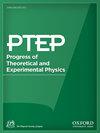A superconducting tensor detector for mid-frequency gravitational waves: its multi-channel nature and main astrophysical targets
IF 8.3
4区 物理与天体物理
Q1 Physics and Astronomy
引用次数: 0
Abstract
Mid-frequency band gravitational-wave detectors will be complementary for the existing Earth-based detectors (sensitive above 10 Hz or so) and the future space-based detectors such as LISA, which will be sensitive below around 10 mHz. A ground-based superconducting omnidirectional gravitational radiation observatory (SOGRO) has recently been proposed along with several design variations for the frequency band of 0.1 to 10 Hz. For two conceptual designs of SOGRO (e.g., SOGRO and aSOGRO), we examine their multi-channel natures, sensitivities and science cases. One of the key characteristics of the SOGRO concept is its six detection channels. The response functions of each channel are calculated for all possible gravitational wave polarizations including scalar and vector modes. Combining these response functions, we also confirm the omnidirectional nature of SOGRO. Hence, even a single SOGRO detector will be able to determine the position of a source and polarizations of gravitational waves, if detected. Taking into account SOGRO’s sensitivity and technical requirements, two main targets are most plausible: gravitational waves from compact binaries and stochastic backgrounds. Based on assumptions we consider in this work, detection rates for intermediate-mass binary black holes (in the mass range of hundreds up to 105 M⊙) are expected to be 0.0065 − 8.1 yr−1. In order to detect stochastic gravitational wave background, multiple detectors are required. Two aSOGRO detector networks may be able to put limits on the stochastic background beyond the indirect limit from cosmological observations.中频引力波超导张量探测器:其多通道性质和主要天体物理目标
中频段引力波探测器将是现有地基探测器(灵敏度高于 10 赫兹左右)和未来天基探测器(如 LISA)的补充,后者的灵敏度将低于 10 mHz 左右。最近提出了一个地基超导全向引力辐射观测站(SOGRO),以及 0.1 至 10 赫兹频段的几种设计变体。我们研究了 SOGRO 的两种概念设计(如 SOGRO 和 aSOGRO)的多通道性质、灵敏度和科学案例。SOGRO 概念的主要特点之一是有六个探测通道。每个通道的响应函数都是针对所有可能的引力波极化(包括标量和矢量模式)计算的。结合这些响应函数,我们还确认了 SOGRO 的全向性。因此,即使只有一个 SOGRO 探测器也能确定引力波源的位置和极化(如果探测到的话)。考虑到 SOGRO 的灵敏度和技术要求,有两个主要目标是最有可能的:来自紧凑双星和随机背景的引力波。根据我们在这项工作中的假设,中等质量双黑洞(质量范围在数百到 105 M⊙)的探测率预计为 0.0065 - 8.1 yr-1。为了探测随机引力波背景,需要多个探测器。两个 aSOGRO 探测器网络可能能够对随机背景进行限制,使其超出宇宙学观测的间接限制。
本文章由计算机程序翻译,如有差异,请以英文原文为准。
求助全文
约1分钟内获得全文
求助全文
来源期刊

Progress of Theoretical and Experimental Physics
PHYSICS, MULTIDISCIPLINARY-PHYSICS, PARTICLES & FIELDS
CiteScore
12.00
自引率
5.70%
发文量
148
审稿时长
17 weeks
期刊介绍:
Progress of Theoretical and Experimental Physics (PTEP) is an international journal that publishes articles on theoretical and experimental physics. PTEP is a fully open access, online-only journal published by the Physical Society of Japan.
PTEP is the successor to Progress of Theoretical Physics (PTP), which terminated in December 2012 and merged into PTEP in January 2013.
PTP was founded in 1946 by Hideki Yukawa, the first Japanese Nobel Laureate. PTEP, the successor journal to PTP, has a broader scope than that of PTP covering both theoretical and experimental physics.
PTEP mainly covers areas including particles and fields, nuclear physics, astrophysics and cosmology, beam physics and instrumentation, and general and mathematical physics.
 求助内容:
求助内容: 应助结果提醒方式:
应助结果提醒方式:


